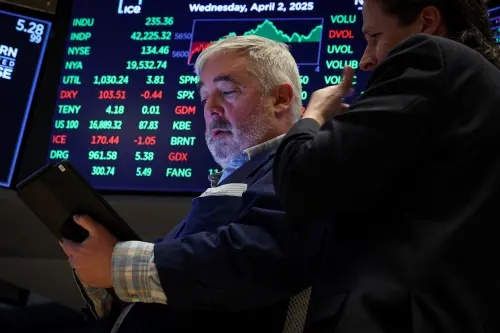Introduction
Heavyweight technology stocks drove a significant selloff on Wall Street following President Donald Trump's recent trade policy announcements, which raised fears of a trade war and the potential for a global economic recession.Context
Investors reacted by moving away from risky assets, opting instead for the safety of government bonds after Trump instituted a 10% tariff on most goods imported into the United States, along with much higher tariffs on several other countries. These tariffs are expected to disrupt global trade and unsettle businesses, marking a notable shift from earlier months when promises of business-friendly policies had propelled U.S. stocks to record highs.Developments
On Thursday, high-profile technology stocks experienced significant declines:- Apple sank 8.4%, significantly impacted by a 54% tariff on China, where much of its manufacturing is based.
- Nvidia dropped 6.2%.
- Amazon.com fell 7.4%.
Sam Stovall, chief investment strategist at CFRA Research, stated that the tariff announcement was much more severe than anticipated, leading to a sharp decline in stocks due to expected inflationary impacts. He cautioned that if the Trump administration resists negotiation, retaliatory tariffs could escalate the situation further.
Notably, China and the European Union pledged retaliation, with the latter facing a 20% duty. Other trading partners, such as South Korea, Mexico, and India, have opted to postpone their responses while seeking concessions before the tariffs are implemented on April 9.
At 11:32 a.m., the Dow Jones Industrial Average fell 1,427.21 points, or 3.38%, to 40,798.11. The S&P 500 lost 227.51 points, or 4.00%, to 5,444.20, and the Nasdaq Composite decreased by 899.29 points, or 5.11%, to 16,701.76. The CBOE Volatility Index, often referred to as Wall Street's fear gauge, reached a three-week high at 26.91 points.
Since Trump's inauguration in January, U.S. stocks have declined, with the S&P 500 and Nasdaq each falling 10% from their record highs, indicating a market correction in response to tariffs' anticipated damage to the economy and businesses. Following the president's announcements, traders are now adjusting their expectations for the U.S. Federal Reserve to implement four interest rate cuts this year, beginning with a quarter-point reduction in June. This creates heightened anticipation for the upcoming payroll data and Fed Chair Jerome Powell's speech, which may provide critical insights into the economy's health and future interest rate direction.
Retailers were significantly affected on Thursday, including:
- Gap, which fell 10.2%.
- Ralph Lauren, down 16%.
Large banks sensitive to economic fluctuations, such as Citigroup and Bank of America, each dropped by approximately 10%, while JPMorgan Chase & Co declined 6.3%. The U.S. small-cap Russell 2000 index fell 5.9%, reflecting concerns over domestic economic health. Additionally, oil stocks like Exxon Mobil and Chevron experienced losses of about 5% each, as crude prices plummeted 7% amid Trump's tariffs and OPEC+'s acceleration of output hikes.
The market environment was overwhelmingly negative, with declining issues outnumbering advancers by a ratio of 5.16-to-1 on the NYSE and 6.04-to-1 on the Nasdaq. The S&P 500 recorded 33 new 52-week highs against 80 new lows, while the Nasdaq Composite saw 21 new highs and 545 new lows.
